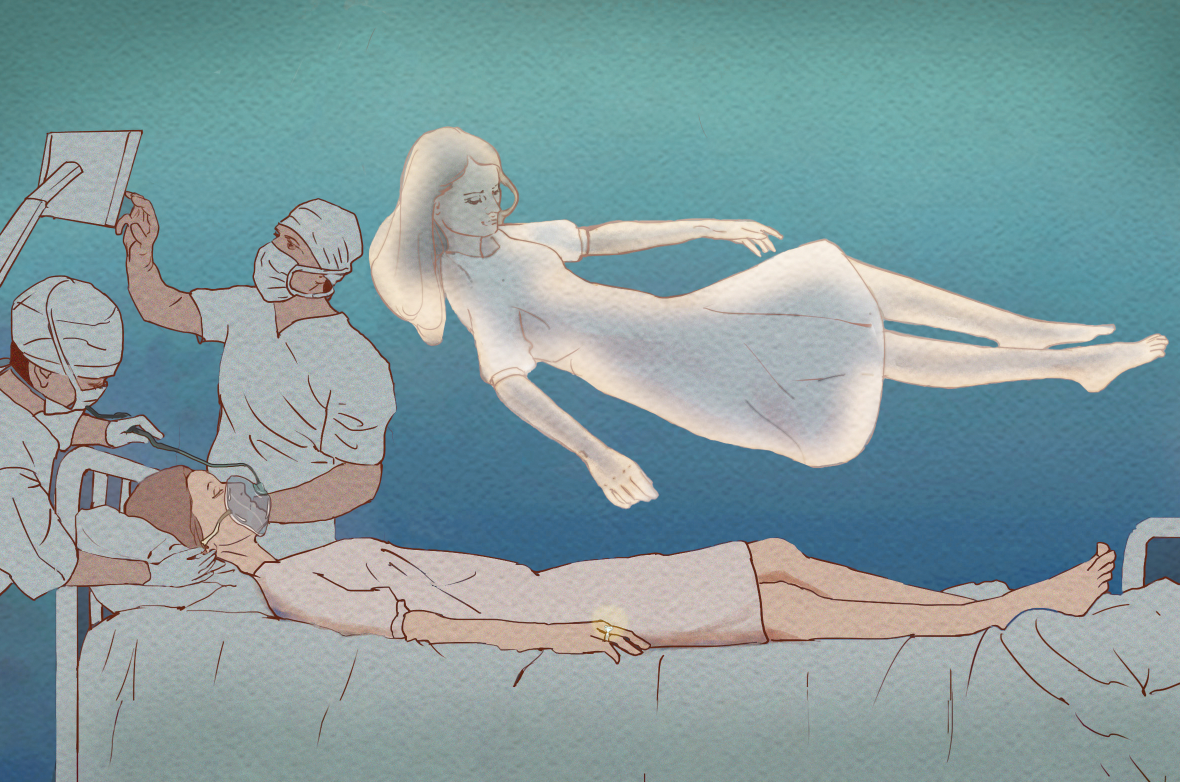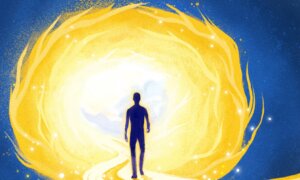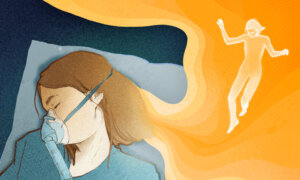Vicki Umipeg was born prematurely at 22 weeks, weighing only 3 pounds. Her optic nerve was damaged due to high oxygen in the incubator, resulting in complete blindness. She had no visual experiences, no awareness of light whatsoever.
At the age of 22, she was thrown out of a car in Seattle, resulting in severe injuries—skull fractures, concussion, and injuries to her neck, back, and leg. While being rescued in the hospital, she found herself floating to the ceiling.
She had panoramic vision and saw a woman’s body lying on a metal operating table, with a male and female medical staff member each working to save her. When she noticed the distinct wedding ring on the prone woman’s hand, she realized it was her ring, and the woman lying there was her.
As she had been blind all her life, she had never seen that ring or her body. Only in that near-death experience (NDE) did she see her ring.
Vicki was the research subject of Dr. Jeffrey Long, a practicing radiation oncologist in Kentucky. Long has dedicated over 25 years to studying NDEs. He has researched and reviewed more than 4,000 cases of unique NDEs and published them on his website, the Near-Death Experience Research Foundation.
Long summarized the most common experiences of NDE based on his research, similar to what Dr. Raymond Moody, the “father of NDE,” has found. They are as follows:
- Out-of-body experience
- Absence of pain
- Passage through a tunnel toward a bright light
- Encountering deceased loved ones in a heavenly realm
- Undergoing a profound life review
- Feeling overwhelming love and peace
Vicki’s case falls under the typical “out-of-body experience.” Her experience, especially the panoramic vision, is shared by all those who undergo NDEs.
360-Degree Vision
In a recent conversation with The Epoch Times, Long recalled his conversation with the blind woman.
“She had a 360-degree vision, where she could simultaneously be aware of and process vision during her near-death experience: in front of her, behind her, right, left, up, down.
“In fact, I told Vicki that the rest of us in our earthly lives have these pie-shaped visual fields because of the location of our eyes, in our eye sockets. She literally laughed at me because her entire life experience with vision [during her NDE] was in 360 or spherical vision.”
Though initially unfamiliar with math and science, Vicki intuitively grasped calculus and understood how planets are formed after her NDE. She gained answers to questions about science, math, life, planets, and God, experiencing a flood of knowledge and understanding languages she didn’t know before.
From Delusion to Reality
In the past, people who reported NDEs were often dismissed by the scientific community as delusional or religiously influenced until a significant shift in perspective over the past few decades.
In 1978, five independent medical doctors and scientists—John Audette, who has a master of science degree; Dr. Bruce Greyson; Dr. Raymond Moody; Ken Ring, who has a doctorate in social psychology; and Dr. Michael Sabom—co-established the International Association for Near-Death Studies, paving the way for exploring these extraordinary experiences through the scientific lens.
“I first heard about near-death experience decades ago when I was in my residency training,” Long said, “and in one of the world’s most prestigious medical journals, the Journal of the American Medical Association.
“I was flipping through the journal looking for a cancer-related article, and totally by accident, found the phrase ‘near-death experience’ in the title of an article. I was puzzled because nothing I’d learned in medical school explained that. You’re either alive or dead.”
The article was written by Sabom, a cardiologist who studied people who had survived cardiac arrest and coma. Some patients reported that their consciousness came out of their bodies and observed what was happening while they were unconscious, he wrote. What they described seeing was accurate down to the finest details.
Several years later, the wife of one of Long’s college friends shared her detailed and remarkable NDE with him.
“During a surgery under general anesthesia, she went into cardiac arrest due to an allergic reaction, meaning her heart stopped,” Long said.
“At that point, she had an out-of-body experience, witnessing the chaos in the operating room and hearing the loud alarm from the EKG monitoring her heart. She briefly passed through a tunnel and found herself in a non-earthly realm where she encountered other beings. There, she was given a choice about returning to her life. She asked the beings for guidance, and after some conversation, she decided to return to her body. She was successfully resuscitated.”
Long wondered why more people weren’t researching this fascinating phenomenon, so he began collecting NDE cases. He built a database of 4,000 of them—“By far the largest publicly accessible collection of near-death experiences in the world,” he told The Epoch Times.
In a survey, he asked people directly about the reality of their experience, and nearly 95 percent of respondents said their experience was “definitely real.”
The 30 Failed Hypotheses
According to Long, people who are skeptical about NDEs have proposed more than 30 explanations for these experiences.
“The reason that there are so many of these skeptical explanations—over 30 floating around—is very simple,” Long told The Epoch Times. “None of the skeptical explanations explain anything during the near-death experience, let alone everything that occurs.”
To debunk NDEs, hypotheses of hallucinations induced by hypoxia (decreased oxygen levels) and hypercarbia (increased carbon dioxide) were raised. The reason these fail is simple: “Medically, that results in confusion and diminished consciousness, not increased,” Long said.
A study in The Lancet studied hundreds of patients who were successfully resuscitated after cardiac arrest or clinical death. Eighteen percent of those patients reported NDE. If cerebral hypoxia is what causes NDEs—and everyone clinically dead has hypoxia—then most of these patients should have had an NDE, said the researcher. However, this was not the case.
Others have argued that endorphins—the brain’s naturally produced narcotic-like substance—might explain NDEs. However, endorphins continue to exert their post-event pain-relieving effect on the brain for over an hour, which is not aligned with NDE, Long said.
“With near-death experiences, the moment they return to their physical body—boom—there’s no relief of pain or anything; they’re instantly having pain,” Long said.
Others have proposed seizures. But Long said, “Seizures generally cause reduced or substantially altered consciousness, not the lucid, consistent experiences.”
Ernst Rodin, the former president of the American Clinical Neurophysiology Society, commented, “In spite of having seen hundreds of patients with temporal lobe seizures during three decades of professional life, I have never come across that symptomatology [NDE] as part of a seizure.”
The Lancet study also concluded that patients’ medication or fear of death were found not to be associated with NDEs.
‘Doubly Impossible’
NDEs have even been documented under general anesthesia.
“Under general anesthesia, you should have no possible lucid, organized, conscious experience,” Long said.
While under general anesthesia, some people’s hearts stopped. In this case, Long said, it should be “doubly impossible to have any conscious experience.” Yet these people still have the same typically hyper-lucid, hyper-alert, hyper-conscious experience typical of all other NDEs, he added.
“That, almost single-handedly, refutes any possibility that NDEs are due to physical brain function.”
Beyond Cultures, Religion, and Age
Other hypotheses include the psychological model, which proposes that NDEs are caused by imaginations based on personal, religious, or cultural background. However, individuals often report NDEs inconsistent with their life experiences or beliefs regarding death.
Some say NDEs are culturally determined. However, Long has found that the experiences are “remarkably similar wherever in the world they occur.
“No matter where on Earth they happen, it doesn’t make any difference. Whether you’re, say, a Muslim in Egypt or a Hindu in India, a Christian in the United States, or even an atheist everywhere in the world that near-death experiences occur—whatever [a person’s] prior belief system was or wasn’t, what happens during a near-death experience is strikingly similar.”
After the 1976 Tangshan earthquake in China, Chinese scientists observed a similar pattern of NDEs in the Western record.
Among the 81 survivors, 65 percent had heightened clarity of thought, 43 percent felt separation from their physical bodies, and 40 percent felt weightlessness. The experience was similar regardless of age, sex, occupation, or health status before the earthquake.
Long studied a group of children 5 and younger with an average age of 3.5—“practically a culturally blank slate,” he said. “The content of these very young children is strikingly similar to the content of near-death experiences of older children and adults.”
Meeting God
Moody, who started studying NDEs over half a century ago, has pointed out that many near-death experiencers describe encountering a radiant entity known as the “Being of Light,” as Moody describes in his book, “Life After Life: The Investigation of a Phenomenon—Survival of Bodily Death.”
This light is often described as a brilliant and indescribable radiance that doesn’t harm the eyes. Most individuals perceive this light as an advanced being imbued with love and warmth, or God.
Vicki also reported seeing an extraordinarily radiant figure in her NDE; she recognized this as Jesus.
To investigate the truthfulness of “God” in NDEs further, Long conducted research on God between 2011 and 2014 based on 420 cases of NDEs from people of various professions and walks of life.
Before experiencing a near-death event, 39 percent of people believed in the “absolute existence of God.” After their NDE, this belief increased to 72.6 percent. The number of individuals who believed in the absolute existence of God increased by 86 percent, and their faith in God greatly intensified, he wrote in his book, “God and the Afterlife: The Groundbreaking New Evidence for God and Near-Death Experience.”
Long carefully examined 277 encounters with God and found a significant consistency in their descriptions: the presence of an all-loving and all-gracious supreme being radiating love and grace.
Other common features of encounters with God described in NDEs include nonjudgment, acceptance of who the person is, and a sense of unity or oneness with God. Communication is essentially always nonphysical or telepathic in these experiences.
Positive Message
Before delving into NDE research, Long was puzzled by questions like “Who are we?” He felt that we are much more than just the physical operation of our brains.
NDEs provide overwhelming evidence for consciousness apart from the body—a more eternal existence, said Long. We are not just constrained, operating machines but lives with numerous possibilities beyond our current recognition.
This is “the most powerfully positive message” for all of humanity, he added.









